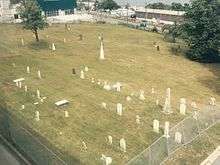Royal Navy Burying Ground (Halifax, Nova Scotia)
|
Royal Navy Burying Ground, Halifax, Nova Scotia | |
 Nova Scotia | |
| Details | |
|---|---|
| Established | 1781 |
| Location | Halifax, Nova Scotia |
| Country | Canada |
| Coordinates | 44°38′36″N 63°34′22″W / 44.6434°N 63.5728°WCoordinates: 44°38′36″N 63°34′22″W / 44.6434°N 63.5728°W |
| Type | Closed |
| Owned by | Naval Museum of Halifax |
| Number of graves | 400+ |
The Royal Navy Burying Ground is part of the Naval Museum of Halifax and was the Naval Hospital cemetery for the North America and West Indies Station at Halifax, Nova Scotia. It is the oldest military burial ground in Canada. The cemetery has grave markers to those who died while serving at Halifax and were treated at the Naval medical facility or died at sea. Often shipmates and officers had the grave markers erected to mark the deaths of the crew members who died while in the port of Halifax.
The number of burials is estimated at over 400, however, there are only 89 stone markers remaining.[1] There was register of deaths established in 1860 for the burial ground. As well Surgeons of a ship registered the deaths of crew members, including how the person died and where they were buried. These reports were interred in the official register, with a detailed account sent quarterly to the Medical Director, General Admiralty, England.[2] There is no local record of who is buried. The four most common causes of death in order are disease, falling from the Topmast, drowning and death as result of naval battles.
Along with two monuments that commemorate casulties of the War of 1812, the most prominent markers are for the crew that died on the Flagships of the North American and West Indies Station:HMS Winchester (1841), HMS Wellesley (1850), HMS Cumberland (1852), HMS Indus (1859), HMS Nile (1861), HMS Duncan (1866) and HMS Royal Alfred (1869).[3] There were many buried during the wars of the 18th century (American Revolution, French Revolutionary War and Napoleonic Wars) that do not have grave markers.
War of 1812
During the War of 1812, 220 British naval sailors died in the Naval Hospital at Halifax.[4] The most famous of these were those that died as a result of the battle between the USS Chesapeake and HMS Shannon.
Crew of USS Chesapeake (1813)
There was a monument erected to the 12 crew who died in the Halifax Naval Hospital on the USS Chesapeake (1966).
Captain Broke boarded Chesapeake at the head of a party of 20 men. They met little resistance from Chesapeake's crew, most of whom had run below deck. The only resistance from Chesapeake came from her contingent of marines. The British soon overwhelmed them; only nine escaped injury out of 44.[5] Captain Broke was severely injured in the fighting on the forecastle, being struck in the head with a sword. Soon after, Shannon's crew pulled down Chesapeake's flag. Only 15 minutes had elapsed from the first exchange of gunfire to the capture.[6][7]
Reports on the number of killed and wounded aboard Chesapeake during the battle vary widely. Broke's after-action report from 6 July states 70 killed and 100 wounded.[8] Contemporary sources place the number between 48–61 killed and 85–99 wounded.[9][10] Discrepancies in the number of killed and wounded are possibly caused by the addition of sailors who died of their wounds in the ensuing days after the battle.[11] The counts for Shannon have fewer discrepancies with 23 killed; 56 wounded.[12] Despite his serious injuries, Broke ordered repairs to both ships and they proceeded on to Halifax, Nova Scotia. Captain Lawrence died en route and was buried in Halifax with military honors. The British imprisoned his crew. Captain Broke survived his wounds and was later made a baronet.[13][14]
 USS Chesapeake - 12 died (1813)
USS Chesapeake - 12 died (1813).jpg) HMS Shannon capturing the USS Chesapeake off Boston, 1 June 1813
HMS Shannon capturing the USS Chesapeake off Boston, 1 June 1813- USS Chesapeake and HMS Shannon
Crew of HMS Shannon (1813)
Admiral of the Fleet Rodney Mundy (Commander-in-Chief, North American Station refurbished the original monument that was created for the 7 who died in the Naval Hospital who served on the HMS Shannon (1868). [15]
Shannon’s midshipmen during the action were Messrs. Smith, Leake, Clavering, Raymond, Littlejohn and Samwell. Samwell was the only other officer to be wounded in the action. Mr Etough was the acting master, and conned the ship into the action. Shortly after the frigate had been secured, Broke fainted from loss of blood and was rowed back to Shannon to be attended to by the ship's surgeon. After the victory, a prize crew was put aboard Chesapeake and Shannon escorted her and her crew into Halifax, arriving there on 6 June. Lieutenant Bartholomew Kent, of Nova Scotia brought the first news of the British victory back to London.
At Halifax Chesapeake's crew was imprisoned. Chesapeake herself was repaired and taken into service by the Royal Navy before she was sold at Portsmouth, England in 1820 and broken up.
 HMS Shannon - 7 died (1813)
HMS Shannon - 7 died (1813).jpg) HMS Shannon leading the USS Chesapeake into Halifax Harbour in June 1813.
HMS Shannon leading the USS Chesapeake into Halifax Harbour in June 1813.
Flagships of the North America and West Indies Station (1850-1869)
The following is a list of the Flagships that commemorated their lost crew members through erecting a monument in the Burying Ground. Some monuments reflect those killed in a single event and other monuments include all those who were killed while the Flagship was stationed on the North America and West Indies Station at Halifax. After the names of the ship there is a date that is the year the last person listed on the monument died.
Crew of HMS Winchester (1841)
In 1828, Charles Austen, brother of novelist Jane, was nominated by Sir Edward Griffith Colpoys to be his flag captain aboard HMS Winchester, while at Halifax.[16]
.jpg) HMS Winchester (1841)[17]
HMS Winchester (1841)[17]
 Capt. Austen, commanded HMS Winchester in Halifax (1828-1830) (Jane Austen's brother)[18]
Capt. Austen, commanded HMS Winchester in Halifax (1828-1830) (Jane Austen's brother)[18]
Crew of HMS Wellesley (1850)
There is a monument to 11 crew that died over a two year period on HMS Wellesley, North America & West Indies at Halifax (1848-1850). The ship was commanded by Captain George Goldsmith and was the flagship of Vice-Admiral Thomas Cochrane, 10th Earl of Dundonald , North America and West Indies.
 HMS Wellesley - 11 died (1850)
HMS Wellesley - 11 died (1850) Thomas Cochrane
Thomas Cochrane HMS Wellesley
HMS Wellesley "Captain George Goldsmith RN, H.M. Ship Wellesley, Halifax" , July 1850
"Captain George Goldsmith RN, H.M. Ship Wellesley, Halifax" , July 1850
Crew of HMS Cumberland (1852)
There is also a monument to 6 crew who died on the flagship HMS Cumberland from 1851-1852. The commander was Captain George Henry Seymour and his father was the Vice Admiral Sir George Francis Seymour. [19]
 HMS Cumberland - 6 died (1852)
HMS Cumberland - 6 died (1852) Sir George Francis Seymour
Sir George Francis Seymour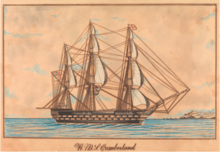 H.M.S. Cumberland, c.1852
H.M.S. Cumberland, c.1852
Crew of HMS Indus (1859)
The crew and officers of the HMS Indus created a gravestone for one of their fellow crew members who died (1859). The vessel was the flagship of Sir Houston Stewart, Vice- Admiral in the Blue. The commander was Captain William King-Hall.
- Sir Houston Stewart
 1 died - HMS Indus and Squadron leaving Halifax Harbour, 1858
1 died - HMS Indus and Squadron leaving Halifax Harbour, 1858 Captain William King-Hall and crew, HMS Indus, Halifax, Nova Scotia, 1860
Captain William King-Hall and crew, HMS Indus, Halifax, Nova Scotia, 1860
Crew of HMS Nile (1861)
Admiral of the Fleet Sir Alexander Milne, 1st Baronet (Commander-in-Chief, North American Station at Halifax,1860–64) erected a monument to his son and 14 other crew members who died over a period of 18 months on Flagship HMS Nile (1861).[20] The Admiral's son was one of 6 who died in one week. Two more died within the month. (Note: There is another stone that commemorates a single crew member. No date.)
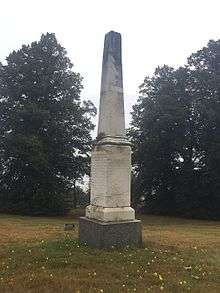 HMS Nile Monument - 16 died (1861)
HMS Nile Monument - 16 died (1861)%2C_by_Walter_William_Ouless.jpg) Admiral Milne - buried his son
Admiral Milne - buried his son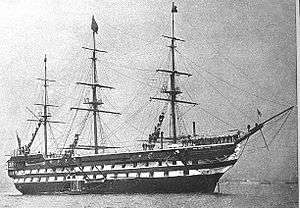
Crew of HMS Duncan (1866)
The Shipmates/ messmates of HMS Duncan erected 4 stones for 5 crew (8 Sept. 1864, 1865, 1865, 1866). 6 January 1864: Commanded by Captain Robert Gibson, flagship of Vice-Admiral James Hope, North America and West Indies.[22] Whilst serving on the North America and West Indies Station, Captain John Bythesea VC was carried on the books of Duncan as second captain from 1 April 1866 to Spring 1867, for special service as Naval Attaché in Washington.[23]
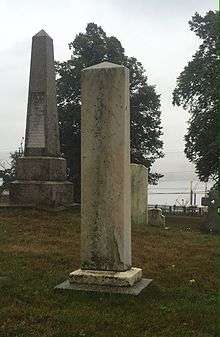 HMS Duncan - 5 died (1866)
HMS Duncan - 5 died (1866)- Sir James Hope
 HMS Duncan, Halifax, Nova Scotia c. 1865
HMS Duncan, Halifax, Nova Scotia c. 1865
Crew of HMS Royal Alfred (1869)
In 1869, a monument to the 4 crew that died on Flagship HMS Royal Alfred was created by Admiral of the Fleet Rodney Mundy (Commander-in-Chief, North American Station).[24] The crew of HMS Royal Alfred have the most markers in the burying ground. There are 7 gravestones for 10 people. The last grave marker was for the infant daughter of the Surgeon on board ship.[25] The Royal Alfred was the flagship of Vice-Admiral Sir George Rodney Mundy, 1867-1869.[26]
 HMS Royal Albert - 10 died (1869)
HMS Royal Albert - 10 died (1869)- Sir Rodney Mundy
 HMS Royal Alfred, Halifax Harbour, NS", ca1870
HMS Royal Alfred, Halifax Harbour, NS", ca1870
Officers
There are only two stones that mark the graves of officers. The identity of the Admiral has never been confirmed.
- Admiral Domes (Barnes? Tomes?) drowned on the HMS Renown ( - 1898),[27]
- Captain George Oliver Evans, ( - 1868) Capt. Royal Marine, Light Infantry, 6 June 1868, 36 years. Captain Evans fought in both the Crimean War: Battle of Balaclava, Siege of Sevastopol (1854–55), Battle of Kinburn (1855) as well as the Second Opium War: Battle of Canton (1857).[28][29] He served as the aid de camp for Sir Thomas Holloway (military officer) (1858–60).[30]
 "HMS Renown", Halifax, Nova Scotia (1898)
"HMS Renown", Halifax, Nova Scotia (1898) Captain George Oliver Evans (1868)
Captain George Oliver Evans (1868)
Individual crew members
Listed below are the ships whose crews commemorated the loss of a single sailor with a gravestone:
- HMS Vernon (1808); HMS Mersey (1820); HMS Alligator (1827); HMS Columbus (1837); HBM Sloop Pilot (1841); HM Steamer Syndenham (1843); HMS Sloop Scourge (1848); HMS Edgar (1862); HMS Meder (1865); HMS Doris (1868); HMS Constance (1868); HMS Valorous (1870); HMC Racoon (1874);[31]
 HMS Vernon (1833)
HMS Vernon (1833).png)
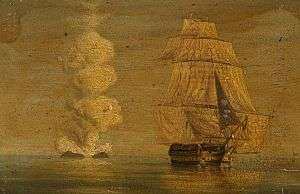 HMS Melville (1837)
HMS Melville (1837) HMS Galatea, 1865 (left of center)[32]
HMS Galatea, 1865 (left of center)[32]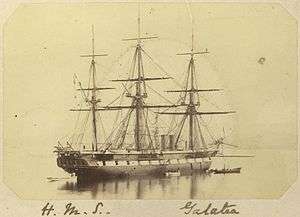 HMS Galatea, Halifax, Nova Scotia, c.1868.
HMS Galatea, Halifax, Nova Scotia, c.1868.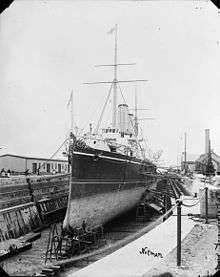 HMS Cresent, Halifax, Nova Scotia (1885)
HMS Cresent, Halifax, Nova Scotia (1885).png) HMS Tournaline (1888)
HMS Tournaline (1888)
Women and children
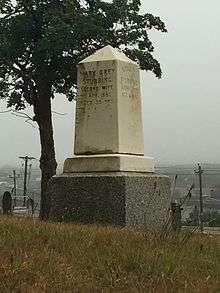
There are also grave stones for women (9) and children (18). Many of the children were infants. The most prominent of these grave markers was erected by Charles Stubbing who was the Admiralty Clerk between 1867 and 1893. He created a grave stone that lists his first and second wife and five of his children. He lost two of his children and his second wife in the same year (1882). He created another grave stone for the loss of his third wife. [33]
Other
The following four ships were not Flagships and had multiple deaths while at the Halifax station, which the crews commemorated by a single monument.
- 6 died –HMS Orion (1854), 1857 – Halifax July 27- August 5, 1857, Captain John Elphinstone Erskine
 HMS Vindictive - 4 died (1846)[34]
HMS Vindictive - 4 died (1846)[34]

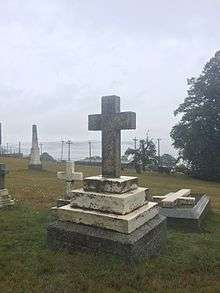 HMS Canada - 3 died (1887)
HMS Canada - 3 died (1887)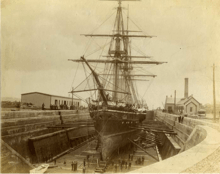
See also
References
Endnotes
- ↑ "Unmarked graves sought in navy cemetery". CBC. 18 July 2011. Retrieved 21 October 2014.
- ↑ There is a list of burials from 1860 until 1905, which was held at the Public Record Office, Chancery Land and is now at the The National Archives (United Kingdom). Collections of the Nova Scotia Historical Society, p. 108
- ↑ https://archive.org/stream/collectionsofnov13nova#page/n121/mode/1up
- ↑ Deborah Trask. Putting the War of 1812 to Rest. Royal Nova Scotia Historical Society Journal. Vol. 18, 2015, p. 61
- ↑ Roosevelt (1883), p. 185.
- ↑ Roosevelt (1883), pp. 186–187.
- ↑ Cooper (1856), p. 307.
- ↑ The London Gazette: no. 16750. p. 1330. 6 July 1813. Retrieved 22 April 2011.
- ↑ Maclay and Smith (1898), Volume 1, p. 459.
- ↑ Beach (1986), p. 110.
- ↑ Toll (2006), p. 415.
- ↑ The London Gazette: no. 16750. p. 1329. 6 July 1813. Retrieved 22 April 2011.
- ↑ Roosevelt (1883), p. 187.
- ↑ Cooper (1856), p. 308.
- ↑ https://archive.org/stream/navalchronicleco30londiala#page/84/mode/1up/search/halifax
- ↑ http://www.warwickleadlay.com/prints/maritime/hms-winchester
- ↑ http://www.warwickleadlay.com/prints/maritime/hms-winchester
- ↑ The diary and private journal of Charles John Austen (latterly Rear Admiral) for 1830 is held by the National Maritime Museum: The Caird Library, Manuscripts Section Record Reference AUS/131-132. NRA catalogue reference. NRA 30121.
- ↑ http://collections.rmg.co.uk/collections/objects/102922.html
- ↑ Commander of HMS Nile Captain Edward King Barnard (b. 1815, later Rear-Admiral Barnard) also was involved in erecting the monument (See p. 48).
- ↑ Images of Nile in Halifax, Nova Scotia
- ↑ Lambert, "Battleships in Transition", p124. Online History HMS Duncan. Lambert says that she became flagship in 1865 and paid off in 1868.
- ↑ Online biography John Bythesea
- ↑ Note Grave marker for Henry Smith Coolen (marker No. 15) indicates the date Nov. 18, 1862 which does not coincide with the dates the HMS Royal Alfred was sailing.
- ↑ Ship Portrait - Royal Albert
- ↑ https://novascotia.ca/archives/royalnavy/archives.asp?ID=29&Language=
- ↑ Died while on board HMS Renown (1895), August 4, 1898. HMS Renown, Flagship of the North America and West Indies Station, under the command of Admiral Sir John A. Fisher, Captain Daniel M Riddel while in Halifax, 1897-1899 (See Riddle). Given the lack of formality of the gravestone, one might conclude that "Admiral Tomes" was a nick name for a crew member rather than an actual Admiral.
- ↑ THE NEW ARMY LIST, AND MILITIA LIST; EXHIBITING THE RANK, STANDING, AND ... By COLONEL H. G. HART, p. 356, Note 98
- ↑ https://books.google.ca/books?id=lu8NAAAAQAAJ&pg=PA345&lpg=PA345&dq=%22George+Oliver+Evans%22,+Capt.+Royal+Marine,+Light+Infantry&source=bl&ots=BxO1SFmV7k&sig=94Bqq-pU5XqVjy11AL7LN5ArmKA&hl=en&sa=X&ved=0ahUKEwj7sYG_u43PAhXIyT4KHe_pBX4Q6AEIJjAD#v=onepage&q=%22G%20O%20Evans%22&f=false
- ↑ p. 400
- ↑ http://www.forposterityssake.ca/GALLERIES/Q079.htm
- ↑ In memory of Alexander F. Carroll Royal Navy who died on board H.M.S. Galatea at Halifax, Nova Scotia June 17th 1865 aged 18 years. See North of Ireland Family History Society
- ↑ Dockyard Memorandum. Nova Scotia Historical Society
- ↑ - 2 stones; 4 crew (1845, 1846)
- ↑ HMS Sphinx stone erected by Capt Thomas Barnardiston; buried at sea because of yellow fever (1874). Note the dates of the grave markers do not coincide with the dates the HMS Sphinx was sailing.
- ↑ p. 958
- ↑ p. 175
- ↑ Capt B. was formerly commander of HMS Rover (1874) (see p. 235.
- ↑ Image of HMS Canada entering dry dock, Halifax Ship Yard
- ↑ HMS Canada (1881), July 10, 1887
Texts
- Pamphlet - Royal Navy Burying Ground: List of known interred. Maritime Naval Museum.
- Charles Stubbing. Dockyard Memorandum. Collections of the Nova Scotia Historical Society
- William Batchell. Old Royal Navy Burial Ground Halifax. 6 Feb. 2016
